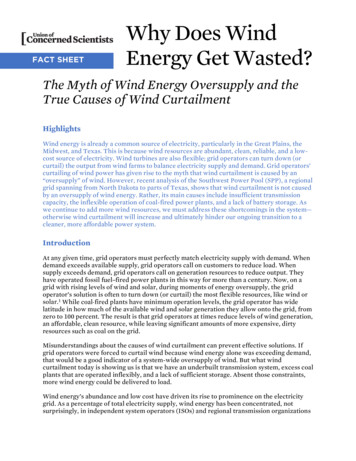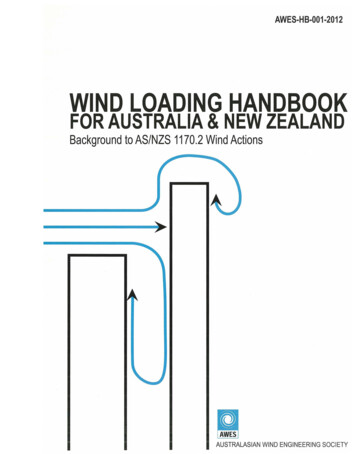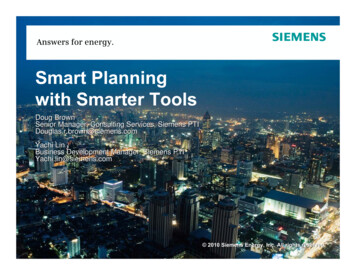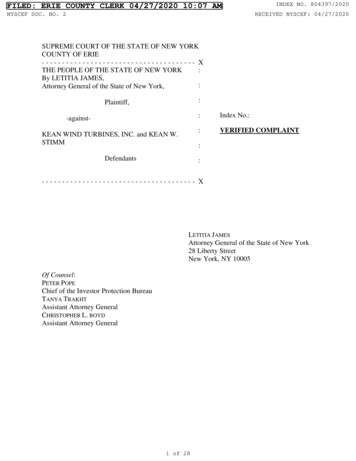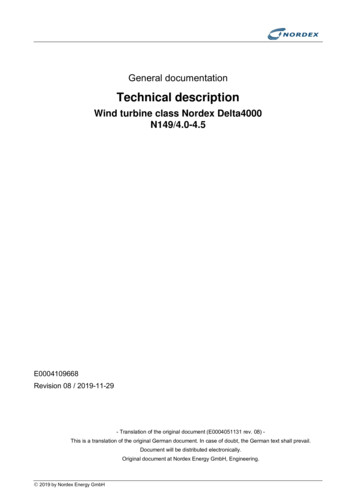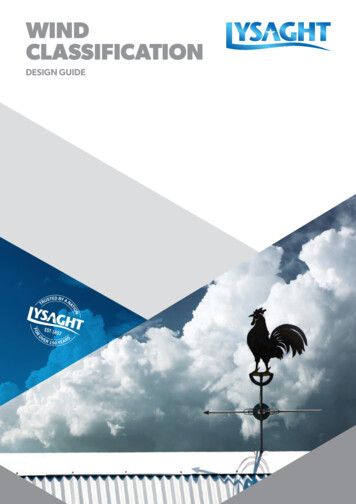
Transcription
WINDCLASSIFICATIONDESIGN GUIDE
SELECTION PROCESS - 5 STEP GUIDETo determine the wind classification for your domestic building site you must consider 4 factors:the Region, the Terrain Category, a Shielding Factor and the Topography.This information is to be used as an approximate guide for residential structures only. This information is basedon the Australian Standard AS4055-2012, wind load for housing. For a detailed analysis refer to the AustralianStandard AS/NZS1170.2:2011.This approach is only suitable for houses up to 2 storeys high and no wider than 16m and 8.5m high.Step 1. Wind RegionChoose your wind region based on the dwelling location.REGION ne50kmREGION yndhamBroomeCroydonOnslowMarble BarMillstream50kmCairnsWest MorelandAthertonREGION BIntermediateTownsvilleCollinsvillePort Headland20oREGION CTropicalCyclonesAdelaide RiverBowen100kmMackayAlice SpringsEmeraldMt roughGascoyne JunctionCallathard25oREGION BIntermediate100km30oREGION ANormalToowoonbaCasinoBrisbaneGraftonCorindiGlen InnisGeraldtonGreen HeadMullewaMorawaGunyidiCoffs HarbourPerthCanberraAdelaideMelbourneREGIONA - NormalB - Intermediate - 100kmsC - Tropical Cyclones - 50kmsD - Severe Tropical CyclonesREGION ANormalHobartSydneyREGION ANormalWIND CLASSIFICATION2
Step 2. Terrain CategoryDetermine your terrain category. The terrain category describesthe surface roughness of the surrounding area 500m from thehousing site.CATEGORY 1 – TC1Very exposed open terrain with few or no obstructions andenclosed limited sized water surfaces, e.g. flat, treeless, poorlygrassed plains, or river, canals, lakes and enclosed bays,extending less than 10 km in the wind direction.CATEGORY 1.5 – TC1.5Open water surfaces subjected to shoaling waves,e.g. near-shore water, large unenclosed bays on seas andoceans, lakes and enclosed bays extending greater than 10kmin the wind direction.CATEGORY 2 – TC2TERRAIN CATEGORY 1 TC 1WIND TERRAIN CATEGORY 1.5 TC 1.5WATERTERRAIN CATEGORY 2 TC 2Open terrain including grassland with well-scattered obstructionshaving heights generally from 1.5m to 5m with no more than twoobstructions per hectare, e.g. farmland and cleared subdivisionswith isolated trees and uncut grass.CATEGORY 2.5 – TC2.5TERRAIN CATEGORY 2.5 TC 2.5Terrain with a few trees or isolated obstructions. This category isintermediate between TC2 and TC3 and represents the terrainin developing outer urban areas with scattered houses, or largeacreage development with fewer than 10 buildings per hectare.CATEGORY 3 – TC3TERRAIN CATEGORY 3 TC 33WIND CLASSIFICATIONTerrain with numerous closely spaced obstructionshaving heights generally from 3m to 10m. The minimumdensity of obstructions shall be at least the equivalent of10 house-size obstructions per hectare, e.g. “suburban housing,light industrial estates”.
Step 3. Shielding FactorDetermine your terrain category. The terrain category describesthe surface roughness of the surrounding area 500m from thehousing site.FULL SHIELDING – FSFull shielding where at least two rows of houses or similar sizepermanent obstructions surround the house being considered.In Regions A & B, heavily wooded areas within 100m of siteprovide full shielding. The effects of roads or other open areaswith less than 100m measured in any direction shall be ignored.Full shielding is for typical suburban development greater than10 houses per hectare. The first two rows of houses abuttingpermanent open areas with a least dimension greater than 100m,such as parklands, large expanses of water and airfields, shall beconsidered to have either partial shielding or no shielding.PARTIAL SHIELDING – PSPartially shielded where there are a least 2.5 houses, trees orsheds per hectare such as acreage type suburban developmentor wooden parkland. The second row of houses are classified aspartially shielded.NO SHIELDING – NSNo shielding where there are no permanent obstructions orwhere there are less than 2.5 obstructions per hectare, such asthe row of houses or single houses.FULL SHIELDING FSWIND THISHOUSE PARTIAL SHIELDING WIND NO SHIELDING WIND PSTHISHOUSE NSTHISHOUSE WIND CLASSIFICATION4
Step 4. Topography EffectThe topographic classification is determined by the effect thewind has on the dwelling due to its position on the hill,designated to be T5.The maximum slope is measured at the steepest part of the hillregardless of where the dwelling is positioned. A cliff is a slope ofgreater than 1 in 3 and has the maximum of T5 at the top. Over thetop of the hill the wind pressures drop down.The bottom of the hill is considered very flat or if the slope isless than a 1 in 20 rise a minimal slope would be classed as T0.Location On Hill (Zone)Maximum SlopesLower ThirdTop ThirdMid ThirdH 10m10m H 30mOver TopH 1T0T2T2T3T4T2T0T2T3T4T5T3 1:20Very Flat 1:20 to 1:10Flat 1:10 to 1:7.5Small Hill 1:7.5 to 1:5Medium Hill 1:5 to 1:3Big Hill 1:3Cliff5WIND CLASSIFICATIONH height of the hill, ridge or escarpment (m)
Step 5. Wind ClassificationWIND CLASSIFICATION SYSTEM FROM AS4055-2012WIND LOAD FOR HOUSINGAS4055 -2012 sets out 10 wind classes N1 N6 & C1 C4. Theclassification is a combination of wind region, terrain category,shielding and topography. By determining the appropriate windclass, the user can use AS4055 and other design aids to designdwelling or parts of dwelling for wind load .5C2C2C31C2C33C2C32.5C221.51BCDTopographic S Full shieldingPS Partial shieldingNS No shieldingN Non-cyclonicC CyclonicN/A Not Available, refer to AS1170.2: 2011.Wind ClassCommon NotationLimit state design gust wind speed (m/s)ServiceabilityUltimateWIND W70C5586Note: N1 N6 are non-cyclonic wind classes, C1 C4 are cyclonic wind classes.6
1) Choose your Wind Region based on your dwelling location. (Section 1)2) Determine the appropriate Terrain Category. (Section 2)3) Select the type of shielding your site has. (Section 3)4) Establish the Topography of your area. (Section 4)EXAMPLES OF THE WIND CLASSIFICATION FOR CITIESAROUND se in the Suburbs - ney in the suburbs - flat- on acreageA- on top of a steep hill/cliff at 28Melbourne, Hobart, Adelaide & Perth in the suburbs- 70C- on top of a hill4Brisbane in the suburbs- flatB- on top of a steep hill5Hervey Bay, Cairns & Darwin in the suburbs- flat away from the beachC- on acreage - flat6Broome, WA in suburbs - flat7Karratha, Dampier, Carnarvon WA in suburbs- flat- suburbs near beachW50CTC3CDT0TC1.5NSWIND CLASSIFICATION2C271Wind ClassPlace
PRODUCT DESCRIPTIONS All descriptions, specifications, illustrations, drawings,data, dimensions and weights contained in this catalogue,all technical literature and websites containing informationfrom Lysaght are approximations only. They are intendedby Lysaght to be a general description for informationand identification purposes and do not create a sale bydescription. Lysaght reserves the right at any time to:(a) supply Goods with such minor modifications fromits drawings and specifications as it sees fit; and(b) alter specifications shown in its promotionalliterature to reflect changes made after the dateof such publication.DISCLAIMER, WARRANTIESAND LIMITATION OF LIABILITY This publication is intended to be an aid for all tradesand professionals involved with specifying andinstalling Lysaght products and not to be a substitute forprofessional judgement. Terms and conditions of sale available at local Lysaghtsales offices. Except to the extent to which liability may not lawfullybe excluded or limited, BlueScope Steel Limited willnot be under or incur any liability to you for any direct orindirect loss or damage (including, without limitation,consequential loss or damage such as loss of profit oranticipated profit, loss of use, damage to goodwill andloss due to delay) however caused (including, withoutlimitation, breach of contract, negligence and/or breachof statute), which you may suffer or incur in connectionwith this publication. Copyright BlueScope Steel Limited 3 May, 2017WWW.LYSAGHT.COMLYSAGHT is a registered trademarks of BlueScope Steel Limited,ABN 16 000 011 058. The LYSAGHT range of products is exclusively madeby or for BlueScope Steel Limited trading as Lysaght.LYT0115 03.05.17Technical enquiries:steeldirect@bluescopesteel.com or call 1800 641 417
CLSSCTION 7 1) Choose your Wind Region based on your dwelling location. (Section 1) 2) Determine the appropriate Terrain Category. (Section 2) 3) Select the type of shielding your site has.



